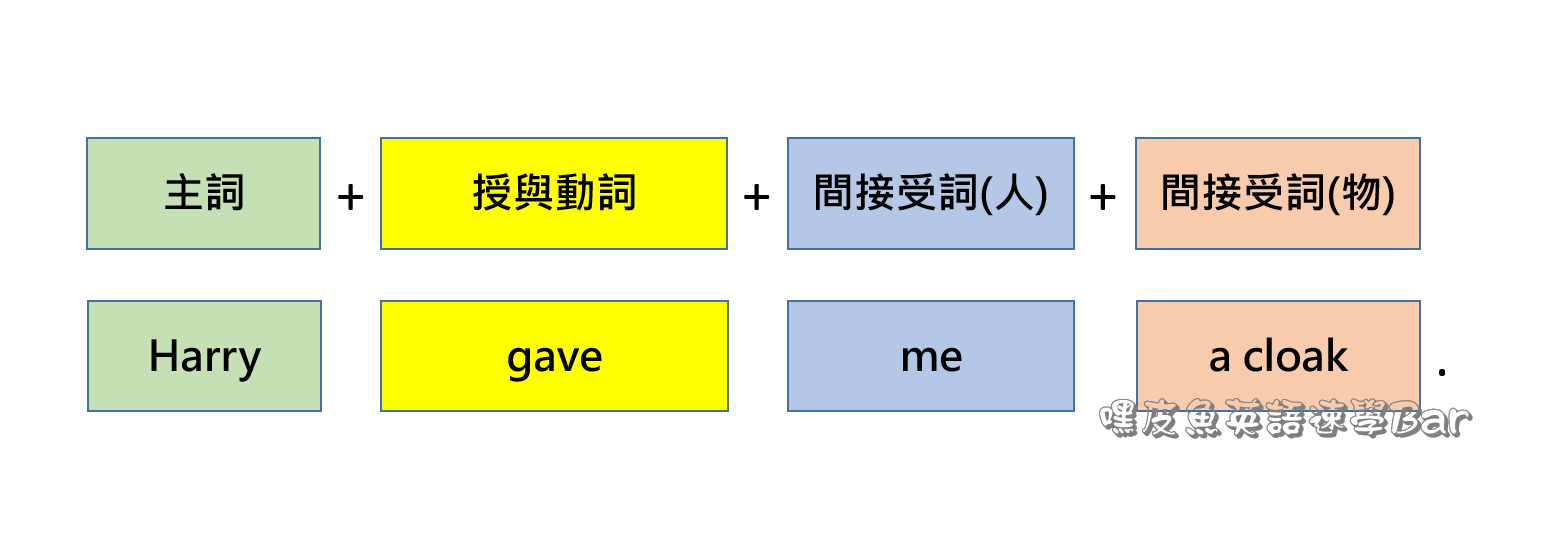授與動詞 用法 |有二個受詞怎麼用?分3組秒記超簡單!
在一般的句子中,動詞後面通常接一個受詞,但某類的動詞後面會需要加二個受詞意思更完整,這種動詞叫做「 授與動詞 」,例如give (給)、send (寄)、teach (教給)、make (做)、buy (買)、cook (煮飯)。
授與動詞 後面會接的二個受詞:「直接受詞」和「間接受詞」。授與動詞意義上接的叫做直接受詞(通常是物),間接碰到動詞的的叫做間接受詞(通常是人)。順序如果是「授與動詞+人+物」就不需要介系詞。如果是「動詞+物+介系詞+人」的順序,需要用不同的介系詞,只要分3組類別記就很簡單喔!
一起來學習常見的授與動詞吧!
授與動詞 的概念
- 授與動詞後面會接的二個受詞,動作的直接接觸者叫做「直接受詞」,間接接觸者是「間接受詞」。
- 例如寄信給朋友,「信」是「寄」這動詞先遇到的對象,是直接受詞,「朋友」是後遇到的動詞,稱為「間接受詞」。
- 順序如果是「授與動詞+人+物」就不需要介系詞。如果是「動詞+物+介系詞+人」的順序,需要用不同的介系詞,只要分3組記類別就很簡單喔!
授與動詞的句型
句型 1:S+授與動詞+人(間接O)+物(直接O)
- 順序如果是「授與動詞+人+物」就不需要介系詞。
- 這個用法比較合乎中文的語序,大家應該不陌生。

Sam showed me his postcards.
(Sam給我看他的明信片。)
→ show + 人 + 物
Angela bought her daughter a beautiful dress.
(Angela給女兒買了一件漂亮的裙子。)
→ buy + 人 + 物
句型 2:S+授與動詞+物(直接O)+介系詞+人(間接O)
- 順序變化就必須加介系詞,句型是「授與動詞+物+介系詞+人」。
- 可以加口訣記成「物介人」。

3. 依照介系詞和意思,分成三組記憶方便又好學:
a. 搭配 to (著重「給」之意):
give (給)、send (寄)、write (寫)、show (給…看)、tell (告訴)、sell (賣)、teach (教)、bring (帶)、lend (借)、pass (傳給)、leave (留給)等。
- Dad told us an interesting story.
= Dad told an interesting story to us.
(爸爸給我們講了一個有趣的故事。)
→ tell + 物 +to + 人
- Allen passed me the salt.
= Allen passed the salt to me.
(Allen遞給我鹽。)
→ pass + 物 + to + 人
b. 搭配for (著重「為了」之意):
make (做)、cook (煮飯)、buy (買)、do (做)等。
- The chef cooked every customer a delicious dish.
= The chef cooked a delicious dish for every customer.
(廚師為每位顧客烹製了美味佳餚。)
→ cook + 物 + for + 人
- Could you do me a favor?
= Could you do a favor for me?
(你可以幫我一個忙嗎?)
→ do + 物 + for + 人
c. 搭配of:
ask (要求)
- The lazy man asked a lot of his family.
(這懶惰的人要求父母很多事情。)
→ ask + 物 + of + 人
- I asked nothing of my son.
(我對兒子不要求任何事。)
→ ask + 物 + of + 人
授與動詞的被動式
- 授與動詞會有二個受詞,在改成被動語態時,只要移動直接受詞,間接受詞仍會需要加上特定的介系詞。
- 直接受詞通常是物,間接受詞通常是人,但也有例外。
| Ken | sent | a letter | to Mia. |
| A letter | was sent | (by Ken) |
(Ken寄了一封信給Mia。)
→ letter是send的直接受詞,改成被動式時,仍保留間接受詞前的to
| Kate | made | a cake | for her sister. |
| A cake | was made | (by Kate) |
(Kate做了一個蛋糕給她妹妹。)
→ cake是make的直接受詞,改成被動式時,仍保留間接受詞前的for
Nick’s brother sent a big parcel to him.
= A big parcel was sent to Nick (by his brother).
(Nick的哥哥寄了一個大包裹給他。)
→ 將直接受詞a big parcel拿來當新的主詞
Someone lent five thousand dollars to Gary .
= Five thousand dollars was lent to Gary (by someone).
(有人借給Gary五千元。)
→ 將直接受詞five thousand dollars拿來當新的主詞
Someone bought some foods for the homeless men.
= Some foods were bought for the homeless men.
(有人為流浪漢買了一些食物。)
→ 將直接受詞some foods拿來當新的主詞
Derek’s parents did much for him.
= Much was done for Derek by his parents.
(Derek的父母為他做了很多。)
→ 將直接受詞much拿來當新的主詞
有紮實的文法概念對於新多益或英檢考試都能輕鬆應付。面對多益100題選擇,絕對要把握前30題用來飆分搶時的文法與單字題。如果要結合新多益(New TOEIC)準備,推薦怪物講師系列。有興趣的朋友,也可以到 博客來網路書店 參考:
- 「全新制50次多益滿分的怪物講師TOEIC多益閱讀攻略+模擬試題+解析(2書)」,整理常考文法、講解清楚,99個攻略,搭配新多益閱讀題與答題秘訣,大推!
- 「全新制20次多益滿分的怪物講師TOEIC多益單字+文法」,這本著重在單字,將文法融入在例句裡,提供不同的學習方式!
✏️牛刀小試 [正解在最後]
- The teacher taught _____________.
(A) the students to the theory
(B) the theory the students
(C) the theory to the students
(D) the theory for the students - Parents are willing to do everything ___________.
(A) for their children
(B) of their children
(C) their children
(D) to their children - 不要要求我給太多東西!(ask … me)
_____________________________
📜 多益文法相關連結:
正解:
1. (C)
2. (A)
3. Don’t ask too much of me!